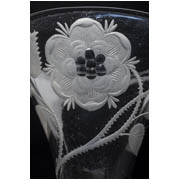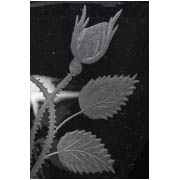Details
- Object type
wine glass
- Place Associated
England (place of manufacture)
- Date
Later 18th century
- Materials
glass
- Dimensions
overall: 168 mm
- Description
-
This eighteenth-century wine glass was engraved to show support to the Jacobite cause. It has a drawn trumpet bowl with air twist stem, supported by a conical foot. The bowl is wheel-engraved with a 6-petal rose in full bloom, with stems, thorns, foliage, and two closed rose buds.
Jacobitism supported the restoration of King James VII and II, and his successors, to the British throne from 1688 to 1788 to replace King William III, Queen Anne and then the Hanoverians, commencing with reign of George I in 1714. The followers of James give themselves the name ‘Jacobite’ after Jacobus’ the Latin translation of the name ‘James’. The court of King James VII and II was forced into exile, was based in France and then Italy, however support remained strong in Scotland. From the 1680s onwards, there were several armed Jacobite uprisings. Two of the largest came after King James VII and II’s death in 1701, focussed on his son James Francis Edward Stuart, known as ‘The Old Pretender.’ After the uprising in 1715 in support of James Francis Edward Stuart failed, a second large uprising was led in 1745 by James Stuart’s son, Charles Edward Stuart, known as Bonnie Prince Charlie or ‘The Young Pretender’ He led an army of Jacobite supporters to victory at Prestonpans, but in 1746 fled to Europe following defeat at the hands of the Duke of Cumberland, at Culloden, the last battle to be fought on mainland Britain.
Support for the Jacobite cause was expressed in many ways. The government’s laws criminalised open support for it. To avoid being convicted of treason, Jacobites would use coded imagery to show support. English made drinking glasses engraved with Jacobite motifs were often commissioned and used by wealthy supporters to allude to their political sympathies and secretly toast to the Stuart monarchy.
A common symbol found on engraved Jacobite glasses was the 6-petal white rose in full bloom, with foliage and thorns. The engraved full bloom rose on this glass is also accompanied by a two rose buds, possibly symbolising the growing Stuart lineage of James Francis Edward Stuart, and his son, Charles Edward Stuart, respectively.
The stem is decorated with an air twist formed by a series of air threads contained with the stem. Air twist stems became fashionable in English glass drinking vessels from around 1735. The twist stem was formed by pressing on a gather of molten glass with a circle of nails fixed onto suitable wooden former. The nails would be removed leaving indentations on the glass. The indentations would then be covered with more molten glass, trapping and enclosing threads of air between the new layer of glass and the previously made indentations. The stem was then drawn out and simultaneously twisted, pulling the trapped air threads, helping to form the spiral as seen in this stem.
- ID Number
E.1961.7
- Location
Kelvingrove Scottish Identity




